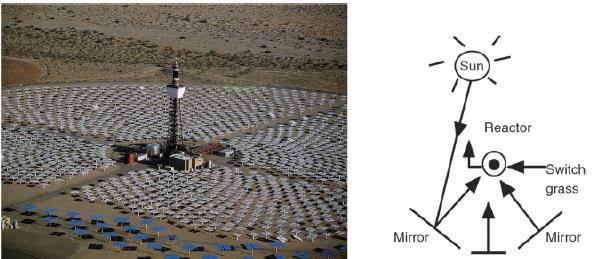Solar energy capture has great potential to help meet the worlds growing energy demand, which is 12
Question:
Solar energy capture has great potential to help meet the world’s growing energy demand, which is 12 terawatts in 2010 and is
expected to rise to 36 terawatts in 2050. Professor Al Weiner and his students at the University of Colorado are engaged in developing methods of utilizing solar thermal energy. In solar thermal reactors, mirrors are used to focus and concentrate the sun’s energy on a flow-type cavity reactor where temperatures as high as 1200°C can be realized, as shown in Figure P8-16.1.
Figure P8-16.1
Solar field design. Five 265-m-tall towers with three heliostat fields/tower, on 275 acres of land in Daggett, CA. Net concentration 3,868 suns and 295 MW delivered to each solar reactor. (Melinda M. Channel, Jonathan Scheffe, Allan Lewandowski, and Alan W. Weimer, November 11, 2009. Also see: Chemical Engineering, 116, p. 18, March 2009. Photo by Glowimages/Getty.) (http://www.sciencedirect.com/science/article/pii/S0009250907005878 and http://www.sciencedirect.com/science/article/pii/S0038092X03004663) A photograph of a solar field is shown, where the tower is present in the center with heliostats surrounding it. An illustration depicts the process involved in capturing solar energy. Three mirrors are present in such a way that the two present on either side of the third are inclined. The energy from Switchgrass and the sunlight reflected from the mirrors are delivered to the reactor.
The switch grass is fed to the 1200°C solar thermal reactor. At these temperatures, biomass can be converted to CO and H2, that is, syn gas, which then can be used
for liquid fuels. Switch grass, which is approximately ⅔ cellulose (C6H10O5) and ⅓ lignin (C10H12O3) will be fed with steam to produce CO, H2, and a small amount of ash, which we will neglect. In order to simplify this process into a tractable home problem, we assume the switch grass is volatilized immediately upon entering the plugflow
reactor and that the reactions and postulated rate laws are
a. Plot and analyze the molar flow rates as a function of PFR volume up to V = 0.417 dm3.
b. Plot and analyze YC, YW, YL, and S˜CO/H2 down the reactor. Describe what you find.
Step by Step Answer:






